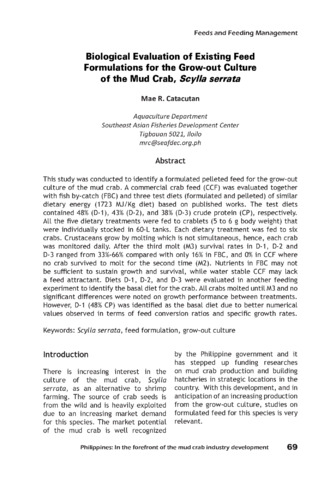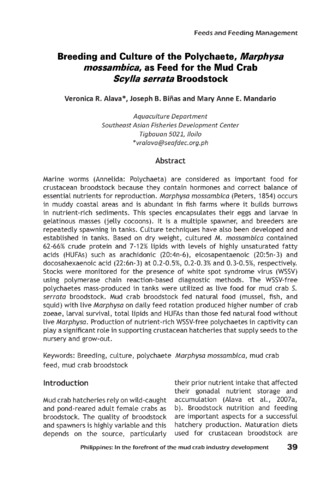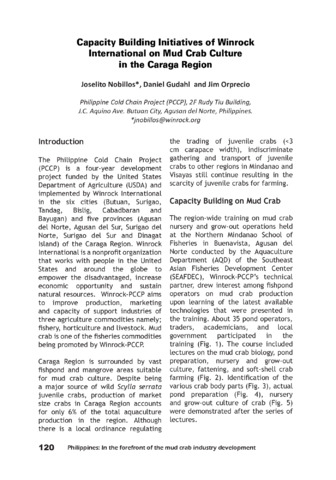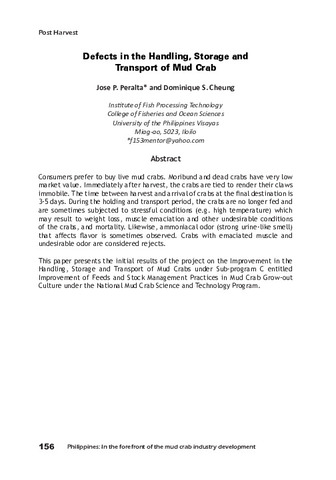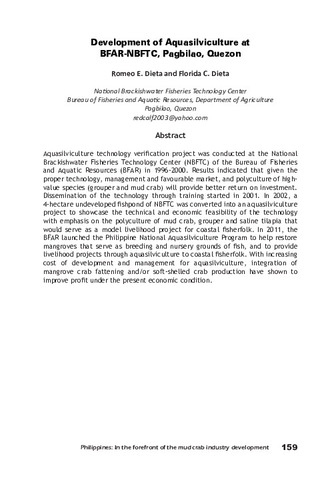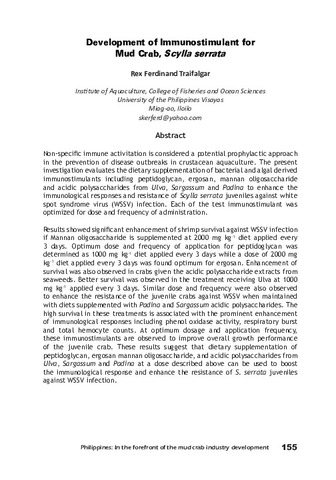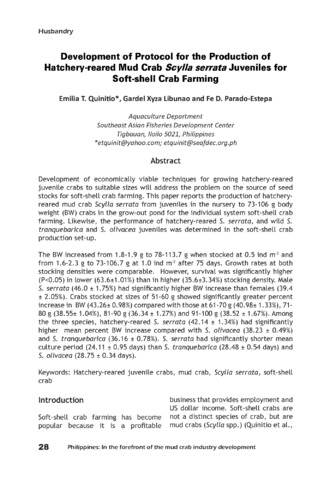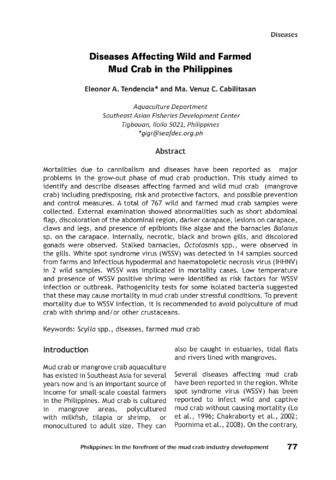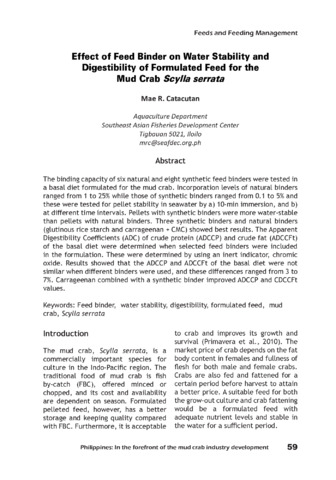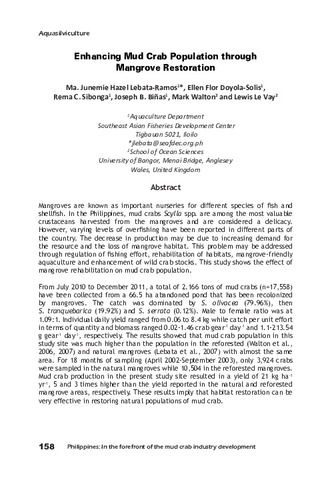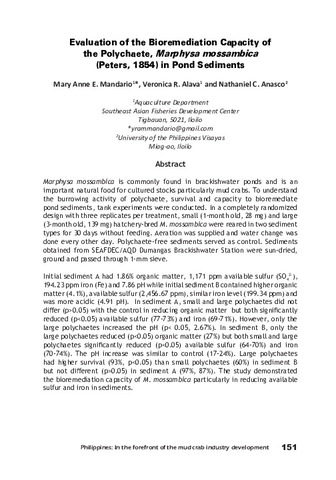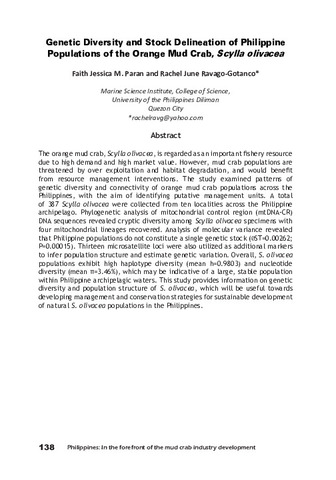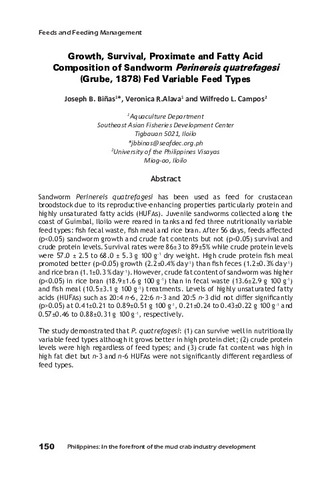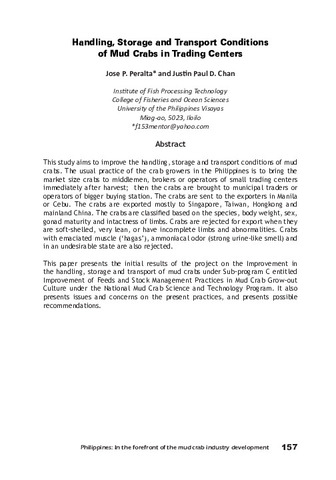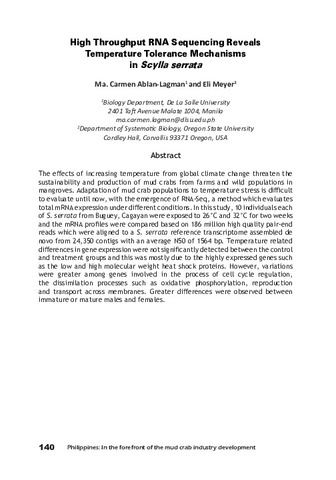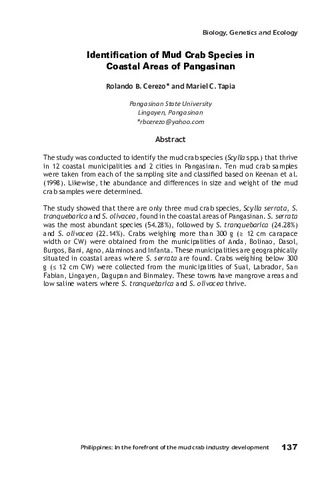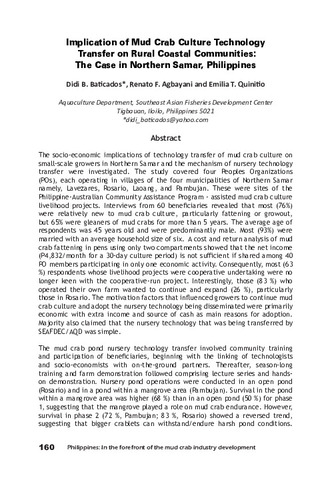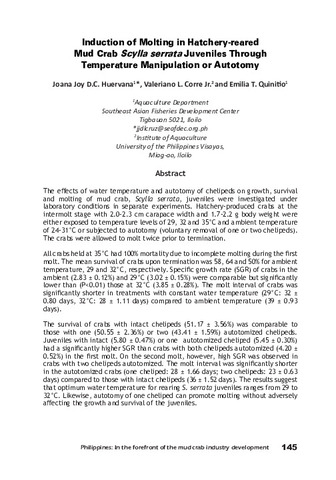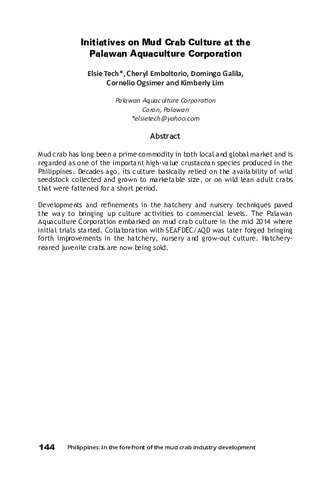Browsing Philippines : In the forefront of the mud crab industry development by Title
Now showing items 2-21 of 44
-
Biological evaluation of existing feed formulations for the grow-out culture of the mud crab, Scylla serrata
(Aquaculture Department, Southeast Asian Fisheries Development Center, 2017)This study was conducted to identify a formulated pelleted feed for the grow-out culture of the mud crab. A commercial crab feed (CCF) was evaluated together with fish by-catch (FBC) and three test diets (formulated and ... -
Breeding and culture of the polychaete, Marphysa mossambica, as feed for the mud crab
(Aquaculture Department, Southeast Asian Fisheries Development Center, 2017)Marine worms (Annelida: Polychaeta) are considered as important food for crustacean broodstock because they contain hormones and correct balance of essential nutrients for reproduction. Marphysa mossambica (Peters, 1854) ... -
Capacity building initiatives of Winrock International on mud crab culture in the Caraga Region
(Aquaculture Department, Southeast Asian Fisheries Development Center, 2017)The paper presents the output of the capacity building initiatives of Winrock International on Mud crab culture in the Caraga Region, Philippines. The capacity building seminar included lectures on the mud crab biology, ... -
Defects in the handling, storage and transport of mud crab
(Aquaculture Department, Southeast Asian Fisheries Development Center, 2017)Consumers prefer to buy live mud crabs (Scylla). Moribund and dead crabs have very low market value. Immediately after harvest, the crabs are tied to render their claws immobile. The time between harvest and arrival of ... -
Development of aquasilviculture at BFAR-NBFTC, Pagbilao, Quezon
(Aquaculture Department, Southeast Asian Fisheries Development Center, 2017)Aquasilviculture technology verification project was conducted at the National Brackishwater Fisheries Technology Center (NBFTC) of the Bureau of Fisheries and Aquatic Resources (BFAR) in 1996-2000. Results indicated that ... -
Development of immunostimulant for mud crab, Scylla serrata
(Aquaculture Department, Southeast Asian Fisheries Development Center, 2017)Non-specific immune activitation is considered a potential prophylactic approach in the prevention of disease outbreaks in crustacean aquaculture. The present investigation evaluates the dietary supplementation of bacterial ... -
Development of protocol for the production of hatchery-reared mud crab Scylla serrata juveniles for soft-shell crab farming
(Aquaculture Department, Southeast Asian Fisheries Development Center, 2017)Development of economically viable techniques for growing hatchery-reared juvenile crabs to suitable sizes will address the problem on the source of seed stocks for soft-shell crab farming. This paper reports the production ... -
Diseases affecting wild and farmed mud crab in the Philippines
(Aquaculture Department, Southeast Asian Fisheries Development Center, 2017)Mortalities due to cannibalism and diseases have been reported as major problems in the grow-out phase of mud crab production. This study aimed to identify and describe diseases affecting farmed and wild mud crab (mangrove ... -
Effect of feed binder on water stability and digestibility of formulated feed for the mud crab Scylla serrata
(Aquaculture Department, Southeast Asian Fisheries Development Center, 2017)The binding capacity of six natural and eight synthetic feed binders were tested in a basal diet formulated for the mud crab. Incorporation levels of natural binders ranged from 1 to 25% while those of synthetic binders ... -
Enhancing mud crab population through mangrove restoration
(Aquaculture Department, Southeast Asian Fisheries Development Center, 2017)Mangroves are known as important nurseries for different species of fish and shellfish. In the Philippines, mud crabs Scylla spp. are among the most valuable crustaceans harvested from the mangroves and are considered a ... -
Evaluation of the bioremediation capacity of the polychaete, Marphysa mossambica (Peters, 1854) in pond sediments
(Aquaculture Department, Southeast Asian Fisheries Development Center, 2017)Marphysa mossambica is commonly found in brackishwater ponds and is an important natural food for cultured stocks particularly mud crabs. To understand the burrowing activity of polychaete, survival and capacity to ... -
Genetic diversity and stock delineation of Philippine populations of the orange mud crab, Scylla olivacea
(Aquaculture Department, Southeast Asian Fisheries Development Center, 2017)The orange mud crab, Scylla olivacea, is regarded as an important fishery resource due to high demand and high market value. However, mud crab populations are threatened by over exploitation and habitat degradation, and ... -
Growth, survival, proximate and fatty acid composition of sandworm Perinereis quatrefagesi (Grube, 1878) fed variable feed types
(Aquaculture Department, Southeast Asian Fisheries Development Center, 2017)Sandworm Perinereis quatrefagesi has been used as feed for crustacean broodstock due to its reproductive-enhancing properties particularly protein and highly unsaturated fatty acids (HUFAs). Juvenile sandworms collected ... -
Handling, storage and transport conditions of mud crabs in trading centers
(Aquaculture Department, Southeast Asian Fisheries Development Center, 2017)This study aims to improve the handling, storage and transport conditions of mud crabs. The usual practice of the crab growers in the Philippines is to bring the market size crabs to middlemen, brokers or operators of small ... -
High throughput RNA sequencing reveals temperature tolerance mechanisms in Scylla serrata
(Aquaculture Department, Southeast Asian Fisheries Development Center, 2017)The effects of increasing temperature from global climate change threaten the sustainability and production of mud crabs from farms and wild populations in mangroves. Adaptation of mud crab populations to temperature stress ... -
Identification of mud crab species in coastal areas of Pangasinan
(Aquaculture Department, Southeast Asian Fisheries Development Center, 2017)The study was conducted to identify the mud crab species (Scylla spp.) that thrive in 12 coastal municipalities and 2 cities in Pangasinan. Ten mud crab samples were taken from each of the sampling site and classified based ... -
Implication of mud crab culture technology transfer on rural coastal communities: The case in northern Samar, Philippines
(Aquaculture Department, Southeast Asian Fisheries Development Center, 2017)The socio-economic implications of technology transfer of mud crab culture on small-scale growers in Northern Samar and the mechanism of nursery technology transfer were investigated. The study covered four Peoples ... -
Induction of molting in hatchery-reared mud crab Scylla serrata juveniles through temperature manipulation or autotomy
(Aquaculture Department, Southeast Asian Fisheries Development Center, 2017)The effects of water temperature and autotomy of chelipeds on growth, survival and molting of mud crab, Scylla serrata, juveniles were investigated under laboratory conditions in separate experiments. Hatchery-produced ... -
Initiatives on mud crab culture at the Palawan Aquaculture Corporation
(Aquaculture Department, Southeast Asian Fisheries Development Center, 2017)Mud crab (Scylla spp) has long been a prime commodity in both local and global market and is regarded as one of the important high-value crustacean species produced in the Philippines. Decades ago, its culture basically ... -
Management strategies for grow-out culture of mud crab
(Aquaculture Department, Southeast Asian Fisheries Development Center, 2017)There is an increasing interest in mud crab farming because of the growing demand for mud crab in domestic and international markets. Different methods for rearing crabs in ponds, pens and cages have evolved through several ...

